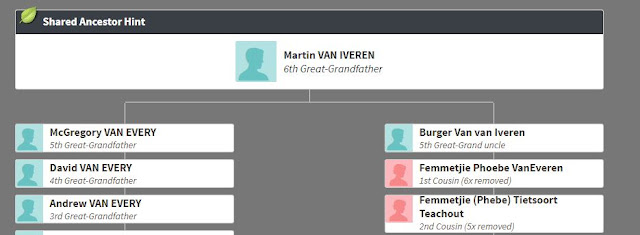Back in 2016 I blogged about the possibility of a
Van Every Surname Non-Paternity Event. Several researchers have questioned the parentage of McGregor Van Every (1723-1786). One theory being Martin Van Iveren and an unnamed McGregor mother. One theory being a McGregor father and an unnamed Van Iveren/Vanevery mother.
Either way, there would be Van Every DNA in the descent, so the only way to prove the theories would be through a Y-surname test of a multitude of Van Every male descendants. Which I am not one.
Back in 2016 I noted that in all of my matches, I had 2nd cousins, 3rd cousins, 4th cousins, and 5th cousins, all sharing a Van Every common ancestor. Nothing higher than 5th cousins. All descendants of McGregor's son, David. If there was no Non-Paternity-Event, or even if there was, and one of the prevailing theories was true, one would expect more distant Van Every cousins.
A Shared Ancestor Hint popped up at AncestryDNA recently. (Excerpt below)
This provided a lot of excitement. Though I knew even with the two prevailing theories, I should have a match with someone descended from Martin Van Iveren. So even though our Family Trees matched up, it didn't prove anything. It was nice to see.
And then I checked the individual's Shared Matches.
As I said above, I have DNA matches who are 2nd through 5th cousins, all descended from David Van Every. Not one of them is a shared match with this individual.
Martin Van Iveren is in both of our online family trees. I think I am fairly sure that's not where our shared DNA resides. All of our shared matches have Eastern European Jewish DNA. That's the 75% of my ancestry that doesn't come from my maternal grandmother, Myrtle Van Every Deutsch. [It is fun to see a cousin from that 75% also has Van Iveren/Van Every ancestry.]
Which raises the question again. If neither I, nor any of my Van Every DNA cousins, share any Van Every DNA with this descendant of Martin Van Iveren...is it possible there was a Non-Paternity Event that completely broke the DNA trail. (Like an adoption?) It's certainly possible. Of course, the lack of evidence isn't proof of anything. It just continues to raise the question.












